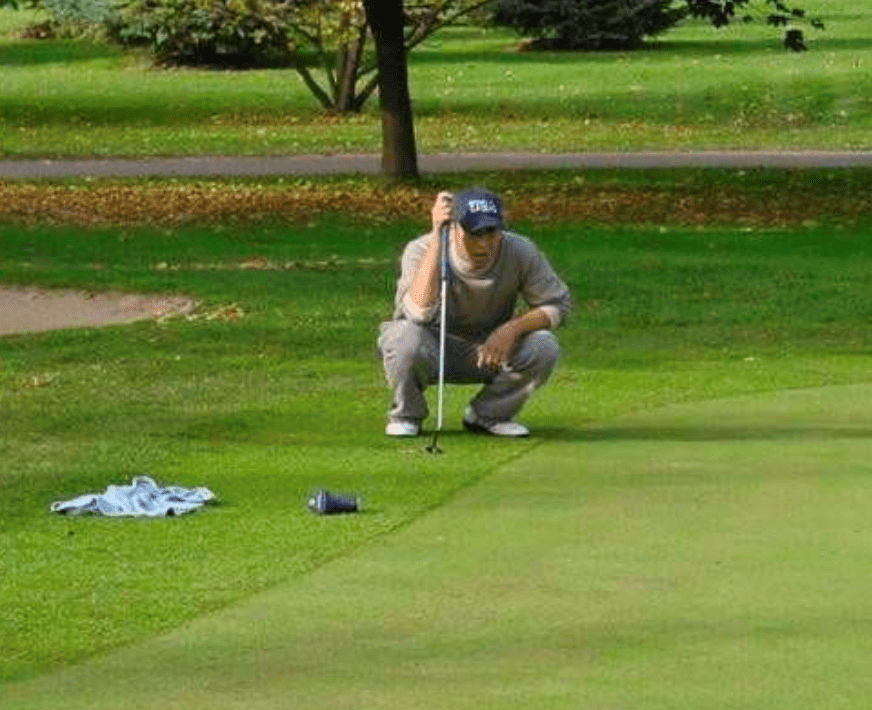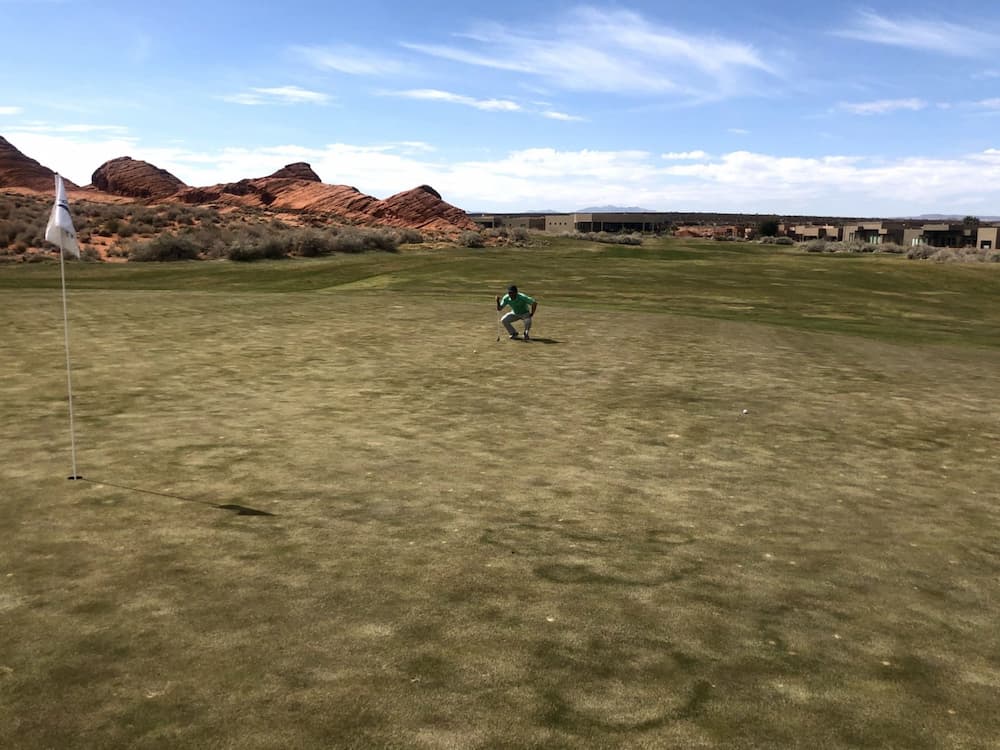You can have the best putting stroke in the world but if you can’t read greens, it will not matter. You need the perfect combination of reading the green and executing the putt in order to make the golf ball go into the hole.
There is no one formula when learning how to read greens but you can break it down by spending time on a practice putting green. Your goal is not to see if your putts go into the hole but rather focus on reading each putt and finding out if you read that putt correctly. Dedicate your time once in a while on just reading putts as it can give you the confidence your putting stroke needs.
There is such a mind game in putting that can affect your putting stroke to whether you think you can make every putt or your hands sweating because you are doubting every putt read because you are just trying not to three-putt.
I tell my students to take two golf balls to the practice green when learning how to read any putts. Make sure when you find a spot to put from, make sure they are all from different area locations and lengths. After reading them, use the first ball to see if you read the putt correctly and putt the second ball to confirm your proper read or to re-adjust your mis-read.
Below I will teach you some methods on helping you read greens properly and to build confidence in each putt you make. Once you master reading greens, you’ll putt like a pro!
Practice Putting on the Practice Green
Every course has different greens that can change daily due to previous and current weather, grass type, grass length, etc. Make sure you practice some putts before you play that day to determine the speeds of the greens and how much they will break.
I usually try to read greens as if I were playing to see how much the greens break with the pace of them. Practice the short ones then make sure you take some longer ones to see how they roll out compared to what you read. This can give you the confidence on hole 1 green even if it’s a longer putt.
Grass type can also matter. Bent grass greens are different from Bermuda grass greens so depending on the course and the area of the country you play in, make sure you understand that when you putt on Bermuda greens (thicker grass blades are common in the south/south east) it can be slower and can break more than greens with bentgrass.
Bent greens are more common but if you are not able to identify the grass type yourself, you can check the golf course’s website or ask any course pros or landscapers.
Approaching the Green
When you approach each green, use your time well by reading your putts as you walk to your ball. You will be able to get different angles and multiple views of your putting situation when approaching your golf ball. While they don’t always show it on TV, all professional golfers are reading the green before they even step on it.
You also need to start reading the green during your approach if your ball is near but still off the green. This will help you decide whether or not a pitch or chip is the better shot to get as close to the hole as possible on your next shot.
Visualize Your Putts
Good putters can look at a putt and tell you right away how the golf ball will roll with the breaks in the green. They do this by visualizing the ball following a starting line rolling all the way to the hole.
Get a Read First
Most of us play golf socially so it’s not all business all the time. So read your putts first, then socialize away!
Read from Behind
The best angle to read a green is behind the ball on the line to the hole. Kneeling down or getting lower can get you a better view of the contour of the green. This is the most common because it’s the clearest way to see which side of your putt is higher or lower.

Look from the Low, Sloped Side
In addition to reading your putting line from behind the ball, I also recommend looking at your line from the low side if you determine that low side. You may be able to see more of the slope facing you to determine how much lower you are than the other side of your putting line.
Find an Intermediate Target
You want to find a color blemish of grass or maybe an old ball mark to use as a fixed point or the apex of your putting line. Usually pick that target halfway or less to the hole so you can pinpoint your aim. It doesn’t have to be exactly on your line that you read but can use it to visualize your ball on how it will break if it goes right over that mark, or left or right of it.
Walk Around Longer Putts
Longer putts can lead to multiple breaks so make sure you walk around your line to determine if your putt moves at different areas. A good way to break this down is from the hole backwards so determine where your ball needs to be for it to go in the hole, then work back and see where your golf ball needs to be to get to that spot.
You want to break your long putt down in two so determine where your ball should be around the halfway point or a spot that breaks one way. Then determine the first part of that putt on how to get your ball to that fixed spot.
Feel it in Your Feet
You can use your feet to determine if one side is higher than the other.
- Go to a point on your line that you think may break and take your stance close to it. You may feel your feet lower or higher on that side so feel it.
- Many golfers are starting to straddle the putting line and see if one foot is higher than the other one.
Learn from Your Playing Partners
There will be times when you have a putt in the same area as a playing partner. If you are closer to the hole, then your playing partner will putt first, giving you the opportunity to learn from their putt. Be aware of these situations and pay attention to how their putt reacts to the slope of the green, in addition to the speed they putt their golf ball.
You don’t need to stand directly behind them to get a good read on their putt (illegal to stand behind someone’s line of putt unless allowed in team competition). A little trick is to start walking towards their line of putt in preparation for your own putt to get a better vantage point.
Err to the High / Pro Side
There will be times that you are not comfortable with the read or the hole is far away – with a high likelihood you will need another putt. In these instances, always read your putts more on the higher side. They call it the pro side because if your ball is still on the high side when it gets closer to the hole, it still has a chance to go in because your speed may be a factor on how much it breaks the last few rolls and will cover more of the hole.
If your ball is heading to the low side before it gets to the hole, that means the ball is going away from it so there is hardly a chance for it to go in. This is called the amateur side.
Find a Routine
You should have a routine on how you read greens. Most players start off behind the ball looking at the hole. If you are unsure or want another look, go to another method on reading that putt. There is not much time to read greens so being consistent on how you read them can lead to being confident over the ball and making that stroke.
Know the Course Surroundings
On courses close to mountains or the sea/ocean, there can be tendencies of which way the grain falls on the greens. When playing courses for the first time, ask the golf course staff if there are any tips on playing or putting that golf course. Sometimes they have a certain landmark they use as a focal point on how the grain grows on their greens so use that local knowledge to help you read the greens.
Take Advice from your Partner
Receiving or giving advice to a competitor or opponent is technically illegal in the game of golf during official tournaments, but if you are playing a team event, you are allowed to give and receive advice from each other. If you’re playing with friends, it can be helpful to ask to see how others read putts.
One piece of good advice I got from a professional caddie is to know when to ask. This caddie has a system with his golfer that he does not offer his view on reading a putt unless his golfer asks. That golfer wishes to read his own putts unless he asks his caddie for a 2nd opinion.
This way, the golfer can make up his own decision in his head to which way to play it if the views are different. Golfers must be committed to their reads. This is a good example of how a strong relationship between golfer and caddie can lead to lower scores.


